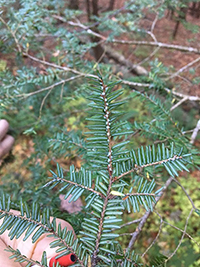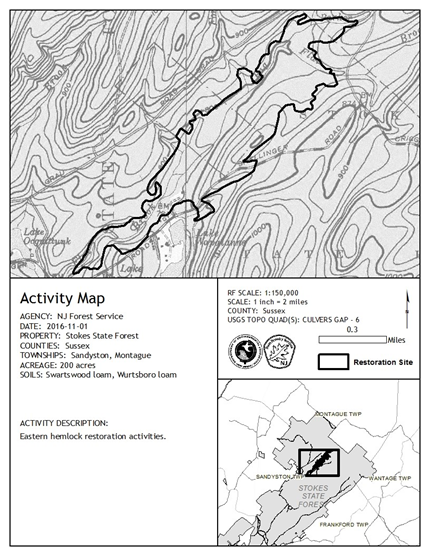Hemlock Propagation Restoration
 LOCATION: Stokes State Forest and Walpack Wildlife Management Area, Sussex County LOCATION: Stokes State Forest and Walpack Wildlife Management Area, Sussex County
PURPOSE: To restore eastern hemlock across the landscape using documented silviculture techniques as well as propagating a new generation of hemlock to artificially plant where hemlocks once grew. The propagation will begin at the State Forest Tree Nursery in Jackson, New Jersey.
BACKGROUND: The permanent decline of Eastern Hemlock, once a dominant tree species in our forests, is due in large part to Hemlock woolly adelgid (HWA). This aphid-like insect feeds by sucking sap from hemlock and spruce trees. It covers itself with a white, waxy "wool" which acts as a protective coating for the insect. In eastern North America, it is a destructive pest that gravely threatens the eastern hemlock and the Carolina hemlock. HWA infestations are easily recognizable by the appearance of tiny "cotton balls" at the base of hemlock needles.
PROJECT SUMMARY: New Jersey Forest Service plans to implement a thinning activity, retaining light while discouraging competing species, on both proposed parcels. Additionally, site preparation to encourage natural regeneration in compacted soil will take place in selected areas by scarification, a proven method to turn the soil to prepare a more fruitful seedbed. Deer fencing may also be erected in order to discourage an overwhelming amount of browse to hemlock. Spot spraying, of a wetland registered pesticide by a licensed applicator will take place in areas showing invasive species to control any spread into the project boundaries.
To propagate hemlock in the State Nursery, equipment such as misting tables and temperature controlled space in the greenhouse will need to be upgraded. On-site staff will be responsible for seed collection, seed preparation through the treatment of each seedling to prevent HWA infestations.
BENEFITS: Hemlocks fulfills a significant role in the forest ecosystem, in that they mainly occur along waterways, such as streams and rivers, and provide the shade and shelter to support important aquatic life. By thinning the forest and growing a new generation of hemlock, NJ Forest Service can begin to reestablish hemlock and its significant role in the landscape.
FUNDING: ONRR is funding this project at the cost of $629,651 to cover the thinning, propagation, and planting efforts.
SCHEDULE: The project will take place over a 5-year period. Work started winter 2017. The effort must be coordinated around timing restrictions for rare species in the area.

|